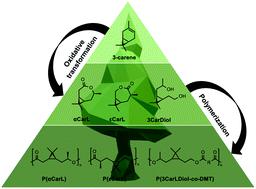当前位置:
X-MOL 学术
›
Polym. Chem.
›
论文详情
Our official English website, www.x-mol.net, welcomes your
feedback! (Note: you will need to create a separate account there.)
Polyester synthesis based on 3-carene as renewable feedstock
Polymer Chemistry ( IF 4.1 ) Pub Date : 2022-06-03 , DOI: 10.1039/d2py00409g Moritz Kränzlein 1 , Stefanie Pongratz 1 , Jonas Bruckmoser 1 , Brigita Bratić 1 , Jonas Martin Breitsameter 1 , Bernhard Rieger 1
Polymer Chemistry ( IF 4.1 ) Pub Date : 2022-06-03 , DOI: 10.1039/d2py00409g Moritz Kränzlein 1 , Stefanie Pongratz 1 , Jonas Bruckmoser 1 , Brigita Bratić 1 , Jonas Martin Breitsameter 1 , Bernhard Rieger 1
Affiliation

|
Utilizing renewable feedstocks for the synthesis of biobased and preferrable biodegradable polyesters as substitute for fossile-based polymers remains one of the major challenges towards a sustainable polymer economy. One such feedstock is turpentine oil, a byproduct from pulp industry which is additionally not competing to crop space. While two of the three main turpentine components found in wood, α-pinene and β-pinene could already be transformed to polyesters, 3-carene as third main component remains so far unexamined. Using a multi-step oxidative transformation involving hydroboration, oxidation and Baeyer–Villiger oxidation for obtaining 3-carene based lactones, two different regioisomers, α-carenelactone (αCarL) and ε-carenelactone (εCarL), could successfully be isolated. Both monomers and a mixture thereof were successfully polymerized using different metalorganic catalysts, yielding two amorphous and one semi-crystalline polyester. Additionally, 3-carene is subject to reductive ozonolysis, providing 3-carene diol (3CarDiol) which could be copolymerized with dimethyl terephthalate to obtain a polyester as well. All polyesters were examined using thermogravimetric analysis and differential scanning calorimetry, revealing glass transition temperatures between −15 to 50 °C and a melting point of up to 170 °C, making these polymers highly promising candidates for further research.
中文翻译:

以 3-蒈烯为可再生原料的聚酯合成
利用可再生原料合成生物基和优选的可生物降解聚酯作为化石基聚合物的替代品,仍然是实现可持续聚合物经济的主要挑战之一。一种这样的原料是松节油,它是纸浆工业的一种副产品,它也不会与作物空间竞争。虽然在木材中发现的三种主要松节油成分中的两种,α-蒎烯和β-蒎烯已经可以转化为聚酯,但作为第三主要成分的 3-蒎烯至今仍未得到检验。使用涉及硼氢化、氧化和 Baeyer-Villiger 氧化的多步氧化转化来获得基于 3-蒈烯的内酯,可以成功分离出两种不同的区域异构体,α-蒈烯内酯 (αCarL) 和 ε-蒈烯内酯 (εCarL)。使用不同的金属有机催化剂成功地聚合了两种单体及其混合物,产生了两种无定形聚酯和一种半结晶聚酯。此外,3-蒈烯经还原臭氧分解,得到3-蒈烯二醇(3CarDiol),它也可以与对苯二甲酸二甲酯共聚得到聚酯。使用热重分析和差示扫描量热法对所有聚酯进行了检查,结果显示玻璃化转变温度在 -15 至 50°C 之间,熔点高达 170°C,这使得这些聚合物非常有希望用于进一步研究。提供可以与对苯二甲酸二甲酯共聚得到聚酯的3-蒈烯二醇(3CarDiol)。使用热重分析和差示扫描量热法对所有聚酯进行了检查,结果显示玻璃化转变温度在 -15 至 50°C 之间,熔点高达 170°C,这使得这些聚合物非常有希望用于进一步研究。提供可以与对苯二甲酸二甲酯共聚得到聚酯的3-蒈烯二醇(3CarDiol)。使用热重分析和差示扫描量热法对所有聚酯进行了检查,结果显示玻璃化转变温度在 -15 至 50°C 之间,熔点高达 170°C,这使得这些聚合物非常有希望用于进一步研究。
更新日期:2022-06-03
中文翻译:

以 3-蒈烯为可再生原料的聚酯合成
利用可再生原料合成生物基和优选的可生物降解聚酯作为化石基聚合物的替代品,仍然是实现可持续聚合物经济的主要挑战之一。一种这样的原料是松节油,它是纸浆工业的一种副产品,它也不会与作物空间竞争。虽然在木材中发现的三种主要松节油成分中的两种,α-蒎烯和β-蒎烯已经可以转化为聚酯,但作为第三主要成分的 3-蒎烯至今仍未得到检验。使用涉及硼氢化、氧化和 Baeyer-Villiger 氧化的多步氧化转化来获得基于 3-蒈烯的内酯,可以成功分离出两种不同的区域异构体,α-蒈烯内酯 (αCarL) 和 ε-蒈烯内酯 (εCarL)。使用不同的金属有机催化剂成功地聚合了两种单体及其混合物,产生了两种无定形聚酯和一种半结晶聚酯。此外,3-蒈烯经还原臭氧分解,得到3-蒈烯二醇(3CarDiol),它也可以与对苯二甲酸二甲酯共聚得到聚酯。使用热重分析和差示扫描量热法对所有聚酯进行了检查,结果显示玻璃化转变温度在 -15 至 50°C 之间,熔点高达 170°C,这使得这些聚合物非常有希望用于进一步研究。提供可以与对苯二甲酸二甲酯共聚得到聚酯的3-蒈烯二醇(3CarDiol)。使用热重分析和差示扫描量热法对所有聚酯进行了检查,结果显示玻璃化转变温度在 -15 至 50°C 之间,熔点高达 170°C,这使得这些聚合物非常有希望用于进一步研究。提供可以与对苯二甲酸二甲酯共聚得到聚酯的3-蒈烯二醇(3CarDiol)。使用热重分析和差示扫描量热法对所有聚酯进行了检查,结果显示玻璃化转变温度在 -15 至 50°C 之间,熔点高达 170°C,这使得这些聚合物非常有希望用于进一步研究。











































 京公网安备 11010802027423号
京公网安备 11010802027423号